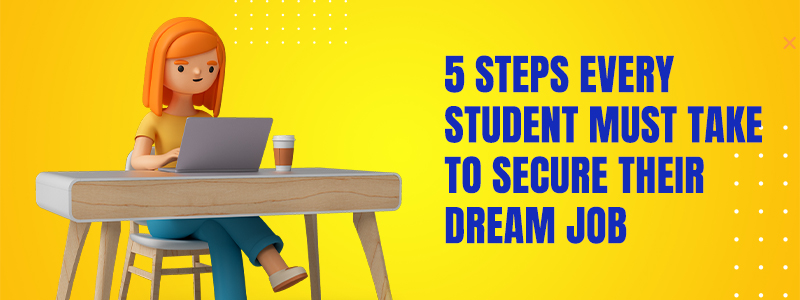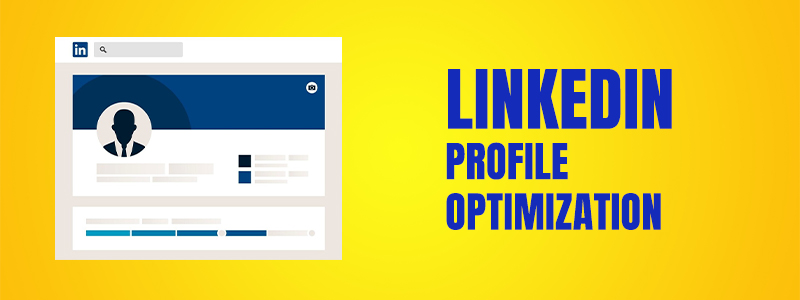Securing a dream job requires students to navigate a series of crucial steps. This guide offers an in-depth exploration of each step's significance, provides strategies for effective preparation, and illustrates their real-world impact. By understanding and mastering these key elements, students can significantly enhance their chances of landing their ideal career opportunity.


LinkedIn Profile Optimization:
LinkedIn is now a key website for finding jobs and networking. Having a good LinkedIn profile is important for students and job seekers. It helps you:
Many recruiters use LinkedIn to find new employees. So, your profile is like an online resume. By making your LinkedIn profile strong, you're giving yourself a better chance to connect with job opportunities and people in your field.
How to prepare:

A student who studied engineering made his LinkedIn profile better. He changed his headline to say things like Data Science Enthusiast and Python Developer. Because of this, someone from a big tech company reached out to him for a job talk. The student didn't even ask for a job there—his better profile caught their eye.
"Your LinkedIn profile is your personal brand. Make sure it tells the story you want to share with the world."
Resume Preparation
Your resume is the document that showcases your qualifications, skills, and experience to potential employers. A well-crafted resume can make the difference between landing an interview or being overlooked.

How to Prepare:
• Emphasize key skills and notable achievements on your resume
• Include a comprehensive list of relevant trainings and workshops attended
• Provide links to your online portfolios (e.g., GitHub, Behance, LinkedIn)
• Detail significant projects or applications you've developed, highlighting:
- Technologies used
- Your role and responsibilities
- Measurable outcomes or impact
• Use action verbs to describe your experiences and accomplishments
• Ensure your resume is well-organized and easy to scan quickly
Cover Letter Preparation
Cover letter is more of a letter where you express your interests and passion. This is the place where you can explain to the recruiter about your goals and efforts you have put to achieve those goals. Here you can explain the role you are expecting and the tech stacks that you would love to work and ones that you are eager to learn.

How to prepare:
1. Strong opening: Start with a compelling introduction that expresses your enthusiasm for the position.
2. Highlight relevant skills: Focus on skills and experiences from coursework, internships, or projects that align with the job requirements.
3. Show passion: Convey your genuine interest in the field and company.
4. Explain why you're a good fit: Connect your skills and goals to the company's needs.
5. Keep it concise: Aim for 3-4 paragraphs, not exceeding one page.
6. Proofread carefully: Ensure there are no spelling or grammatical errors.
7. Use a professional tone: Be polite and formal in your language.
8. Close confidently: End with a call to action, expressing interest in an interview.
Remember, your cover letter should complement your resume, not repeat it. Use it to showcase your personality and enthusiasm for the role.
Self Introduction Preparation
A solid self-introduction is crucial for interviews, professional meetings, and networking events. The way you present yourself can set the tone for the entire interaction, build confidence in your abilities, and leave a lasting impression. Here are some key points to consider:
How to Prepare:
1. Clarity and conciseness: Deliver your introduction in a clear, concise manner that highlights your most relevant qualities and experiences.
2. Body language: Maintain good posture, make eye contact, and offer a firm handshake (when appropriate) to convey confidence and professionalism.
3. Enthusiasm: Show genuine interest and enthusiasm for the opportunity or interaction, as this can be contagious and create a positive atmosphere.
4. Unique selling proposition: Briefly mention what sets you apart or what unique value you can bring to the table.
5. Practice: Rehearse your introduction to ensure it flows naturally and you can deliver it with confidence in various situations.
6. Never repeat: Don't ever repeat what's there in the resume already. Explain your interests and skills that might help you impress the interviewer.
A student was able to confidently introduce herself, briefly explaining her background in graphic design and her interest in UX/UI roles. Her prepared introduction impressed the recruiter, leading to a follow-up interview.
"First impressions matter. A concise, confident introduction can open doors that may have otherwise remained closed."

Technical Preparation
Technical preparation is essential, particularly for jobs in fields like software development, engineering, and data science. Since the curriculum includes the latest technologies, interviewers expect technical expertise even from freshers.

How to Prepare:
Study Core Concepts: Be thorough with the basics and the core technical subjects relevant to your field.
Practice Coding/Problem Solving: Use platforms like LeetCode, HackerRank, and CodeSignal to practice coding challenges.
Mock Interviews: Simulate interviews with peers or seniors/professors to gain real-time feedback.
"Technical interviews aren’t about showing what you know; they’re about demonstrating how you think."
By mastering these five steps, students can significantly improve their chances of landing their dream job.
Each step requires dedication and effort, but the results are well worth it.
About the Author
Steering the helm at LTIMindTree as a Senior Specialist, Senthil Kumar Thangavel role involves crafting high-performance web applications that drive business success. With a solid foundation in the MERN stack, his expertise lies in developing scalable solutions that enhance user experience and operational efficiency.